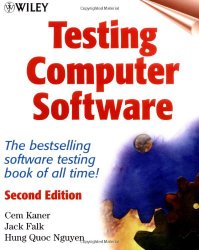Engineering Bookshelf
- Aerospace
- Biological
- Civil
- Chemical
- Environmental
- Electrical
- Materials
- Mechanical
- Petroleum
- Geoengineering
- Software

Testing Computer Software
by Cem Kaner, Jack Falk, Hung Q. NguyenPublisher: Wiley
ISBN: 0471358460
Check price @ amazon.com , amazon.ca , amazon.co.uk
Book Description
This book will teach you how to test computer software under real-world conditions. The authors have all been test managers and software development managers at well-known Silicon Valley software companies. Successful consumer software companies have learned how to produce high-quality products under tight time and budget constraints. The book explains the testing side of that success.
Who this book is for:
- Testers and Test Managers
- Project Managers-Understand the timeline, depth of investigation, and quality of communication to hold testers accountable for.
- Programmers-Gain insight into the sources of errors in your code, understand what tests your work will have to pass, and why testers do the things they do.
- Students-Train for an entry-level position in software development.
What you will learn:
- How to find important bugs quickly
- How to describe software errors clearly
- How to create a testing plan with a minimum of paperwork
- How to design and use a bug-tracking system
- Where testing fits in the product development process
- How to test products that will be translated into other languages
- How to test for compatibility with devices, such as printers
- What laws apply to software quality
About the Author
CEM KANER consults on technical and software development management issues and teaches about software testing at local universities and at several software companies. He also practices law, usually representing individual developers, small development services companies, and customers. He founded and hosts the Los Altos Workshops on Software Testing. Kaner is the senior author of Bad Software: What to Do When Software Fails (Wiley).
JACK FALK consults on software quality management and software engineering management. Jack is certified in Software Quality Engineering by the American Society of Quality. He is Vice Chair of the Santa Clara Valley Software Quality Association and an active participant in the Los Altos Workshops on Software Testing.
HUNG Q. NGUYEN is Founder, President, and CEO of softGear technology. He has worked in the computer software and hardware industries, holding management positions in engineering, quality assurance, testing, product development, and information technology, as well as making significant contributions as a tester and programmer. He is an ASQ-Certified Quality Engineer, and a senior member and San Francisco Section Certification Chairman of the American Society for Quality.
Customer Reviews
By gary.hinson@cccl.net (London, England)
I've had the 2nd edition for about 7 years and still enjoy re-reading this book. Sure, the examples are getting dated now, but in some ways that makes it more interesting (the description of how to populate a printer test room by begging demo printers from the manufacturers always makes me smile). But don't be misled - the core text and concepts are absolutely as relevant today as they ever were.
Software testing and quality can be SUCH dry subjects, but the authors do a wonderful job of bringing them to life. This is a very practical book in the sense that testing processes are described from the point of view of someone who has tried almost everything and knows which approaches are great in theory vs those which actually work. Unlike many others, the book doesn't skirt around human resources issues (such as internal politics, motivation and staff retention) but tackles them head on in the last chapter (it really is worth reading cover-to-cover!).
It is not really a step-by-step instruction manual, more a series of ideas and tips bound together by a coherent story. Us readers really need to think about the topic and work out for ourselves which aspects to apply. That said, some parts are more like a cookbook - there's a good description of a bug tracking process, for example, with some example bug reporting forms and, as always, some excellent advice about cooking your own.
Testing Computer Software has been a great help to me in my role as a computer auditor dealing with numerous application development groups. Project teams rarely have the skills to plan and manage testing properly, and never (in my experience) get the resources to do everything that "needs" to be done before the product ships (just how many groups never really get around to completing the documentation they promised so many months before?). Testing comes at the most time-critical point in the project lifecycle, when everyone is under intense pressure to deliver, fast. This book helps the team plan ahead, preparing the testing organisation and processes to make the inevitable nightmare period pass as smoothly as possible. That includes the audit team, by the way!
The appendix lists 400 types of bugs with their descriptions. As I write this note, I'm using the list to think about tests planned by the project teams I'm currently auditing, looking for holes in their test coverage (no, not 'tick and bash' - I'm trying to help!).
The bottom line: a must read for anyone involved in releasing software.
By Margaret@agtdisd.com (Boulder, Colorado)
I found this book very informative and helpful as a beginning software tester. The authors were very pragmatic and concise in defining different methods and systems to use for testing, and because of this, it is an excellent testing handbook for those people who do not have formal training and need to know where to begin and how to procede in a logical manner. It is also a great reference manual for testing terms that are new to a beginner. Overall, I would highly recommmend this as an excellent textbook for software testing.